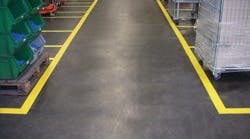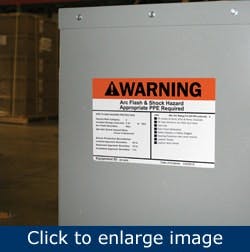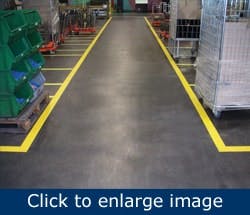In brief:
- The 5S philosophy is a key element of a lean initiative and signage is an excellent enabler of the 5S process. Many industrial hygienists have added a sixth “S” for safety.
- Identify a 5S champion on staff and establish training classes to educate the workforce about the 5S process and the lean manufacturing idea.
- Institute the 5S principles in a small area at first, publish the results, and expand the coverage after each small success.
Sort, set in order, shine, standardize, sustain, and safety are the basics of 5S/6S lean manufacturing thinking in the industrial world. But how many plants actually live by that guideline? Where does one start? Why do they start? Who reaps the business rewards? Getting straight answers from industry veterans is inspirational in this one-step-at-a-time process.
One quick lesson? Often, key 6S messages can be boiled down to what fits on a label. Think “Floor Mop Here,” “Tank #1,” and “Do Not Store Trash in This Area.”
Getting started with 5S/6S
“Begin with the end in mind,” says Joe Schermerhorn, regional industrial engineer at retail food chain, Kroger (www.kroger.com), in Portland, Tennessee. “When developing a plan for streamlining processes, know the goals and work backward to understand the specific steps needed to attain those goals.”
Consider the warehouse. It’s crowded with inventory stacked high on pallets, forklift trucks and people coming and going. When warehouses are poorly run and disorganized, profitability suffers. And that’s a problem.
[pullquote]
So, get people on board through proper training. “Getting everyone on the same page is the first step,” explains Amy Johnson, a buyer for Key Electronics (www.keyelectronics.com), a manufacturing services provider in Jeffersonville, Indiana. “We have an eight-week training program and are working toward getting every employee trained on 5S and lean manufacturing.”
Select one person to be a 5S champion, advises Schermerhorn. “The champion breaks the facility down into zones and assigns an owner to each zone,” he explains. “After that, each zone owner begins the 5S process. The champion scores each zone periodically with scores posted in a central location so everyone can see the results and best practices.”
The major mistake when starting 5S is declaring it an improvement tool, says Manish Kapoor, manager, industrial performance, Unilever India in Chandigarh, India. 5S is about building the base for improvement and making basics right.
Clean up and get rid of waste
It’s hard to think clearly and put energy into a job when you’re surrounded by a mess. We put off what we can’t see. Successful and flourishing companies are clean and organized. Ask yourself these questions.
- Would you eat in a restaurant that was greasy?
- Are there areas in the plant that you’d rather your customers not see?
Sell, scrap or recycle unwanted equipment, suggests Bob Hoffman, quality assurance director at Amitron (www.amitroncorp.com), a PCB manufacturer in Elk Grove Village, Illinois, to recover unused and inefficient floor space for your facility.
Drill Doctor (www.drilldoctor.com) dealt with waste efficiently and sustainably. The drill bit sharpening tool manufacturer headquartered in Ashland, Oregon, donated its outdated inventory — tools that overwhelmed an already crowded warehouse — to high school shop classes.
Now, the warehouse is better organized, and Drill Doctor’s generous gifts continue to help kids develop lifetime job skills in woodworking and metalworking.
Figure 1. Safety is the sixth S in 6S lean manufacturing.
Use visual communication
“We use labels of all shapes and sizes to designate areas for storage, high traffic areas, safety warnings, and overall warehouse definitions,” says Clay Fuller, manager, supply chain systems, at Komatsu America (www.komatsuamerica.com) in Ripley, Tennessee (Figure 1). “We have multiple communication areas that show warehouse performance, 5S, and safety standards. The boards are easily accessible and provide quick updates for warehouse employees and management.”
Visual communications verify that tools are readily available or in use, says Kroger’s Schermerhorn. “They also help standardize the workplace, which has many benefits for inspections, auditing, and everyday use,” he explains.
{pb}
Figure 2. Floor marking tapes for 5S purposes can be both economical and effective.
As signs and labels in industrial environments might be exposed to harsh weather, chemical spills, and forklift traffic, careful consideration should go into these supplies. Continuous vinyl is resistant to most environmental conditions, but specialized materials might be needed in some cases to attain optimal label performance. Certain materials can make labeling faster and easier. Extra-durable printable floor marking tapes make using floor marking for 5S purposes economical and effective (Figure 2). Long-life vinyl is available in multiple colors for 5S-color coded labels. Two-color vinyl allows ANSI-compliant signs and labels to be printed.
Identify any OSHA, MSHA, and ANSI compliance for labels and signs during this process because the entire facility is being examined to identify areas to improve. Of critical importance to the health and well-being of plant workers are:
- leading people to safety in emergencies via NFPA 101-compliant photoluminescent signs and labels
- showing where toxic chemicals are flowing via ANSI A13.1-compliant pipe markers and how to transport chemicals to secondary containers
- communicating safe boundaries for electrical hazards through NFPA 70E 2012-compliant arc-flash labels (anything over 50 V).
“Once we got our labeling system, we noticed countless applications,” says Peggy Nelson, mine safety manager at Barrick Gold/Cortez Mine (www.barrick.com) in Elko, Nevada. “Instead of waiting for months for bulk ordered pre-made signs, now we see a need and fill it right away.”
Management support and 5S evaluation
Management must be committed to the investment if 5S is to be successful. Publish the 5S plan once it’s completed. Allow a comment period for any revisions. Sometimes, ideas don’t always work in the real world or something is overlooked.
“Weaving these practices into the ebb and flow of everyday operations is a struggle,” says Amitron’s Hoffman. “We continue to identify areas and equipment to be minimized.” Measuring 5S progress with required audits and actions and recording the results in a database for top management review is a way to keep key players in the loop. Monthly 5S reports with before and after photos dramatize work in progress and results. Make data and audit results available for review and evaluation. Chart the data to show that the system is working and producing the desired results. If expectations aren’t met, take corrective actions and track results.”
| Martin Carter is senior account manager at Graphic Products (www.graphicproducts.com). Contact Graphic Products at [email protected] or 888-326-9244. |
The key for Komatsu’s distribution center is standardization, explains Fuller. “5S provides the guidelines for maintaining our facility and ensuring that safety and productivity standards can be achieved,” he says. “Team members are aware of 5S requirements in their sections of the warehouse and overall for the facility. 5S makes work easier for all employees and makes improvements and achievements measurable.”
Seeing the result of the 5S transformation is one of the tangible benefits. Post audit results and photographs so that everyone can see the positive results of 5S and be encouraged to continue improving.
Following 5S/6S principles increases worker participation, improves safety, and fosters workplace morale and productivity. Continuous improvement and 5S are important to ISO-certified plants. “We’re always looking to expand our 5S process, provide better tools for accomplishing improvements, and develop visual management processes,” says Fuller.
Implement 5S/6S practices in small areas at first, and then expand one area at a time. Expect a slow start but a rewarding journey.


